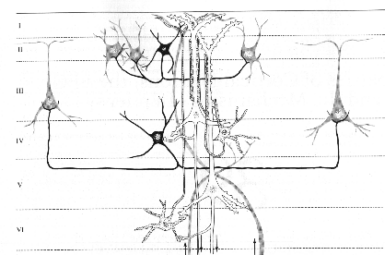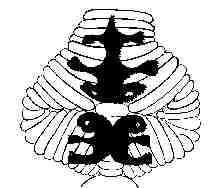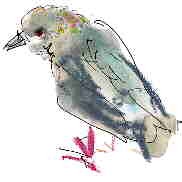Norman
Allan | ||||
chapter four:
Neural nets

Neural nets
a) motor output: the
chirping of a chick

Motor output, motor behaviour,
is a blending of muscle
activity over time.
An example of the organisation of motor
acitivity
is seen in the vocal repertoire of the chick.
Its cheeps and twitters, its trills and shrieks,
are the manifestation of three interacting oscillating systems,
i: one controlling pitch,
ii: a second controlling air pressure
on the "outside" of the vocal membrane,
iii: and a third controlling respiration.
A shift in phase between the first two cycles
reflects
approach/avoidance behaviour,
pleasure and distress
![]()

chapter four, part one
motor output: the chirping of a chick
explains this phenomenon in more detail
b) sensory input: vision
In
the neural organisation of vision we see
multiple
sequential neural representations of the visual field.
Between each of these
successive levels of visual analysis
the information is "processed":
successive levels
(successive mappings of the visual fields)
are iterations
of the informational field/matrix,
similar in many ways to
the field from which they derive
but evolved/different, having
undergone one more (synaptic) process,
and of course with
a small temporal delay
so that these iterations,
this information processing,
is falling down time.
And which of these iterations is the visual field,
is vision itself? Not (necessarily) any one of them.
Possibly the resonance
of all of them.
chapter four,
part two
sensory input: vision
explains this phenomenon in more detail
c) integration and iteration
So we have all
these iteration of neural information
falling down time - and not just our
planar visual matrices -
there are many other body maps (somatotopic maps).
There is the primary sensory and motor cortex, for example,
and "associative"
sensory and motor cortex,
and many somatotopic maps in the cerebellum,

and in the thalamus, and the basal ganglia,
and the spine itself
(there
is a little fusiform homunculus in the spine)
again with successive
iterations of neural process.
And then there will be fields, matrices
which
are integration's of the several (the many) modalities:
an interprocessing
of sight and "balance" (vestibulo-ocular),
of vision and motor control
(e.g. orientation),
of sound and word and memory
~ integrations ~
which means that we don't
just have lines of processes
falling down time in isolated streams,
but
we have a weaving together of these many streams.
And
as successive fields/matrices
are similar, but not the same,
do they not
resonate?
(In chapter one, on homeopathy {"Beyond Substance"}, we saw
[what
for me is compelling evidence] that mind is pattern,but)
where should we look for consciousness?
Certainly not in any one pattern.
Perhaps we should look for it
in the resonance of all the streams
that
the mind references at any one time.
And the
depth and breadth of consciousness,
surely that will reflect size (neurons
per matrix)
and number, number of (sequential) layers
and degree of cross
referencing?
the frog with few, the flat worm with fewer.
The depth
of consciousness in time...
what is it that spans time?
Chapter Five: Strings
Addendum: Strings Between
 |